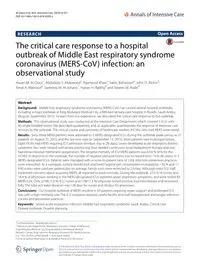
2016 The critical care response to a hospital outbreak of Middle East respiratory syndrome coronavirus (MERS-CoV) infect PDF
Preview 2016 The critical care response to a hospital outbreak of Middle East respiratory syndrome coronavirus (MERS-CoV) infect
Al‑Dorzi et al. Ann. Intensive Care (2016) 6:101 DOI 10.1186/s13613‑016‑0203‑z RESEARCH The critical care response to a hospital outbreak of Middle East respiratory syndrome coronavirus (MERS‑CoV) infection: an observational study Hasan M. Al‑Dorzi1, Abdulaziz S. Aldawood2, Raymond Khan3, Salim Baharoon4, John D. Alchin5, Amal A. Matroud6, Sameera M. Al Johany7, Hanan H. Balkhy8 and Yaseen M. Arabi9* Abstract Background: Middle East respiratory syndrome coronavirus (MERS‑CoV) has caused several hospital outbreaks, including a major outbreak at King Abdulaziz Medical City, a 940‑bed tertiary‑care hospital in Riyadh, Saudi Arabia (August–September 2015). To learn from our experience, we described the critical care response to the outbreak. Methods: This observational study was conducted at the Intensive Care Department which covered 5 ICUs with 60 single‑bedded rooms. We described qualitatively and, as applicable, quantitatively the response of intensive care services to the outbreak. The clinical course and outcomes of healthcare workers (HCWs) who had MERS were noted. Results: Sixty‑three MERS patients were admitted to 3 MERS‑designated ICUs during the outbreak (peak census = 27 patients on August 25, 2015, and the last new case on September 13, 2015). Most patients had multiorgan failure. Eight HCWs had MERS requiring ICU admission (median stay = 28 days): Seven developed acute respiratory distress syndrome, four were treated with prone positioning, four needed continuous renal replacement therapy and one had extracorporeal membrane oxygenation. The hospital mortality of ICU MERS patients was 63.4 % (0 % for the HCWs). In response to the outbreak, the number of negative‑pressure rooms was increased from 14 to 38 rooms in 3 MERS‑designated ICUs. Patients were managed with a nurse‑to‑patient ratio of 1:0.8. Infection prevention practices were intensified. As a surrogate, surface disinfectant and hand hygiene gel consumption increased by ~30 % and 17 N95 masks were used per patient/day on average. Family visits were restricted to 2 h/day. Although most ICU staff expressed concerns about acquiring MERS, all reported to work normally. During the outbreak, 27.0 % of nurses and 18.4 % of physicians working in the MERS‑designated ICUs reported upper respiratory symptoms, and were tested for MERS‑CoV. Only 2/196 (1.0 %) ICU nurses and 1/80 (1.3 %) physician tested positive, had mild disease and recovered fully. The total sick leave duration was 138 days for nurses and 30 days for physicians. Conclusions: Our hospital outbreak of MERS resulted in 63 patients requiring organ support and prolonged ICU stay with a high mortality rate. The ICU response required careful facility and staff management and proper infection control and prevention practices. Keywords: Severe acute respiratory infection, Middle East respiratory syndrome, Saudi Arabia, Critical care, Disease outbreak, Disaster planning © The Author(s) 2016. This article is distributed under the terms of the Creative Commons Attribution 4.0 International License (http://creativecommons.org/licenses/by/4.0/), which permits unrestricted use, distribution, and reproduction in any medium, provided you give appropriate credit to the original author(s) and the source, provide a link to the Creative Commons license, and indicate if changes were made. Open Access *Correspondence:
